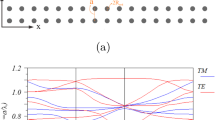Abstract
An electro-optical tunable filter comprised of two paralleled identical long-period waveguide gratings is proposed in this paper. The filter has one input port and two separate output ports, outputting band-pass and band-rejection light respectively. Using poled electro-optical polymer material to fabricate its waveguide cores enable the filter’s tuning speed to approach nanosecond order. With the aid of long-period waveguide gratings, the tuning range of the filter is Λ times larger than the conventional electro-optical filters. We built up a model to design and simulate the proposed tunable optical filter. We investigate the relationship between the parameters of the long-period waveguide grating and the characteristics of the tunable filter, such as tuning range and FWHM. The simulation results show that the tunable optical filter can realize high-speed tuning in the wavelength range of 1530 nm to 1560 nm, and the FWHM width can reach 0.8 nm. Compared with the conventional optical filters, the results show that a high-speed widely tunable optical filter with narrow pass band can be achieved.






Similar content being viewed by others
References
C. S. Goh, S. Y. Set, and K. Kikuchi, “Widely tunable optical filters based on fiber Bragg gratings,” IEEE Photonics Technology Letters 14, 1306–1308 (2002).
T. Hosoi, S. Mizuta, and M. Kitamura, “Practical integrated acousto-optic tunable filter using a focused acoustic beam on X-cut Y-propagating LiNbO3”, in Proceedings of 11th International Conference on Integrated Optics and Optical Fibre Communications, and 23 rd European Conference on Optical Communications (IOOC-ECOC97),( Edinburgh, 1997), Vol. III, pp. 14–18
A. Lipsonand and E. M. Yeatman, “A 1-D Photonic Band Gap Tunable Optical Filter in (110) Silicon,” J. Microelectromechanical Systems 16, 521–527 (2007).
L. Hyung-Kew, K. Kyu-Sang, and Y. Euisik, “A wide-range linearly tunable optical filter using Lorentz force,” IEEE Photonics Technology Letters 16, 2087–2089 (2004).
D. Sadot and E. Boimovich, “Tunable optical filters for dense WDM networks,” IEEE Commun Mag 36, 50–55 (1998).
A. Persoons, T. Verbiest, and E. Lepoudre, "Electrically tunable bandpass filter based on electro-optic polymers," in Proceedings of SPIE-Linear and Nonlinear Optics of Organic Materials II (SPIE 2002), (Seattle,WA,United States,2002), 4798, 129–132.
Y. Bai and K. S. Chiang, “Analysis and design of long-period waveguide-grating couplers,” J Lightwave Technol 23, 4363–4373 (2005).
Y. Bai, Q. Liu, K. P. Lor et al., “Widely tunable long-period waveguide grating couplers,” Opt Express 14, 12644–12654 (2006).
K. S. Chiang, "Widely tunable long-period waveguide grating filters," in Proceedings of SPIE- Passive Components and Fiber-based Devices III (SPIE 2006), (Gwangju, South Korea 2006), 6351, pp. 6351131-13.
S. M. Garner, J. S. Cites, M. He et al., “Polysulfone as an electro-optic polymer host material,” Appl. Physics Lett. 84, 1049–1051 (2004).
H. Nishihara, M. Haruna, and T. Suhara, Optical integrated circuits, Chap 3 (McGraw-Hill Book Company, New York, USA, 1987).
R. Thapliya, T. Kikuchi, and S. Nakamura, “Tunable power splitter based on an electro-optic multimode interference device,” Applied Optics 46, 4155–4161 (2007).
M. Lee, H. E. Katz, C. Erben et al., “Broadband Modulation of Light by Using an Electro-Optic Polymer,” Science 298, 1401–1403 (2002).
K. Zimmer, R. Bohme, and B. Rauschenbach, “Adsorbed layer etching of fused silica by excimer laser with nanometer depth precision,” Microelectron. Eng 78–79, 324–330 (2005).
Y.-P. Wang, J.-P. Chen, X.-W. Li et al., “Fast tunable electro-optic polymer waveguide gratings,” Acta Physica Sinica 54, 4782–4788 (2005). (in Chinese).
T. Erdogan, “Fiber grating spectra,” J. Lightwave Technology 15, 1277–1294 (1997).
Acknowledgments
The authors are grateful for the support through the National Natural Science Foundation of China( No. 60736038), the National High Technology Research and Development Program of China (No.2007AA01Z269), the NCET Program (No. NCET-06-0805), the NCET Program (No. NCET-07-0152) and Sichuan Scientific Funds for Young Researchers (No. 08ZQ026-012). The authors would like to thank Prof. Kin Seng Chiang for helpful discussions on the coupled-mode theory.
Author information
Authors and Affiliations
Corresponding author
Rights and permissions
About this article
Cite this article
Zhang, Q., Liu, Y., Liao, J. et al. Design and Simulation of a Narrow Passband Electro-Optical Tunable Filter with Band-pass and Band-rejection Output. J Infrared Milli Terahz Waves 30, 959–968 (2009). https://doi.org/10.1007/s10762-009-9527-1
Received:
Accepted:
Published:
Issue Date:
DOI: https://doi.org/10.1007/s10762-009-9527-1



